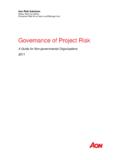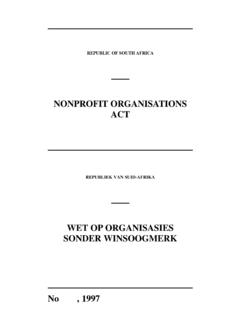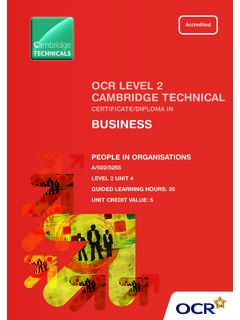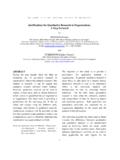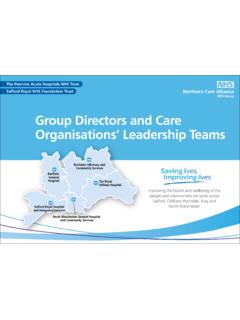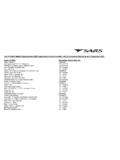Transcription of A review of the literature - Health and Safety …
1 Health and Safety Executive High reliability organisations a review of the literature Prepared by the Health and Safety Laboratory for the Health and Safety Executive 2011 RR899 Research Report Health and Safety Executive High reliability organisations a review of the literature Dr Chrysanthi Lekka Harpur Hill Buxton Derbyshire SK17 9JN A number of major hazard organisations have been attempting to influence the organisational and Safety culture at their sites to transform them into a high reliability organisation (ie organisations that are able to manage and sustain almost error-free performance despite operating in hazardous conditions where the consequences of errors could be catastrophic) with a positive Safety culture. In recent years there has been a huge increase in the literature talking about the control of major hazard risks, in particular the philosophies of high reliability organisations, resilience management and Safety culture.
2 These works identify key features and characteristics that need to be adopted by organisations to achieve ongoing high reliability and Safety objectives. This report and the work it describes were funded by the Health and Safety Executive (HSE). Its contents, including any opinions and/or conclusions expressed, are those of the author alone and do not necessarily reflect HSE policy. HSE Books Crown copyright 2011 First published 2011 You may reuse this information (not including logos) free of charge in any format or medium, under the terms of the Open Government Licence. To view the licence visit , write to the Information Policy Team, The National Archives, Kew, London TW9 4DU, or email Some images and illustrations may not be owned by the Crown so cannot be reproduced without permission of the copyright owner.
3 Enquiries should be sent to ii CONTENTS 1 1 Background .. 1 1 2 2 Identification of 2 Selection criteria .. 2 3 3 Accidents in complex 3 Defining high reliability 5 Characteristics of High reliability organisations .. 6 Assessment of high reliability .. 12 Applications of high reliability organisation principles .. 13 Regulatory perspectives on high 14 4 DISCUSSION AND 17 Summary of reliability-enhancing 17 Limitations of HRO 18 Concluding 20 5 21 iii iv EXECUTIVE SUMMARY Background A number of major hazard organisations have been attempting to influence the organisational and Safety culture at their sites to transform them into a high reliability organisation ( organisations that are able to manage and sustain almost error-free performance despite operating in hazardous conditions where the consequences of errors could be catastrophic)
4 With a positive Safety culture. In recent years there has been a huge increase in the literature talking about the control of major hazard risks, in particular the philosophies of high reliability organisations, resilience management and Safety culture. These works identify key features and characteristics that need to be adopted by organisations to achieve ongoing high reliability and Safety objectives. Objectives The overall aim of this work is to carry out a review of the literature on high reliability organisations in order to identify the characteristics and processes that account for these organisations high Safety and reliability levels. The objectives of the work are as follows: review documents to identify the key characteristics of high reliability organisations for the management of major accident risks, From these high level documents develop descriptions of the key facets, and Critically evaluate research findings on high reliability organisations.
5 Main Findings Key peer-reviewed papers were identified that discussed the processes and practices that are in place in high reliability organisations. The majority of empirical papers on high reliability organisations (HROs) employ a qualitative, case-study approach offering rich descriptions of the types of processes that are in place in these organisations. The many descriptions regarding HROs and their associated processes and characteristics, were summarised in a mind map in order to capture the common issues that emerged in the literature . Containment of unexpected events: Just culture: yDeference to expertise yEncouragement to report without fear of blame yRedundancy yIndividual accountability yOscillation between hierarchical and flat/decentralised structures yAbility to abandon work on Safety grounds yTraining and competence High Reliability Organisations unexpected' events yOpen discussion of errors yProcedures for 'Problem anticipation: Definition: yPreoccupation with failure yTight coupling yReluctance to simplify yCatastrophic consequences ySensitivity to operations yInteractive complexity Learning Orientation: yContinuous technical training yOpen communication yRoot Cause Analysis of accidents /incidents yProcedures reviewed in line with knowledge base Mindful Leadership.
6 YBottom-up communication of bad news yProactive audits yManagement by exception ySafety-production balance yEngagement with front-line staff yInvestment of resources v The mind map used Weick and Sutcliffe s (2007) work on HROs as an overarching, organising framework. In particular, the following facets and processes were characteristic of high reliability organisations: Description of HROs as organisations where failure may have far-reaching, potentially catastrophic consequences. Such organisations will be typically characterised by: o Interactive complexity interaction among system components is unpredictable and/or invisible, and o Tight coupling ( high degree of interdependence among a system s components including people, equipment and procedures).
7 Successful containment of unexpected events by: o Having in place back-up systems in the event of failures and cross-checking of important decisions (redundancy), o Allowing people with expertise, irrespective of rank, to make important Safety -related decisions in emergencies, whilst during routine operations there is a clear hierarchical structure and an understanding of who is responsible for what (deference to expertise in emergencies; oscillation between hierarchical and flat organisational structures), investment in training and technical competence, and o Well-defined procedures for all possible unexpected events. Effective anticipation of potential failures through: o Engagement with front line staff in order to obtain the bigger picture of operations (sensitivity to operations), o Attentiveness to minor or what may appear as trivial signals that may indicate potential problem areas within the organisation and use incidents and near misses as indicators of a system s Health (preoccupation with failure), o Systematic collection and analysis of all warning signals, no matter how trivial they may appear to be, and avoid making assumptions regarding the nature of failures.
8 Explanations regarding the causes of incidents tend to be systemic rather than focusing on individual, blame the operator justifications (reluctance to simplify). Just culture characterised by: o Open reporting systems for near misses and accidents without fear of punishment, o Follow-up of accident investigation outcomes by implementing corrective actions, o Empowering staff to abandon work on Safety grounds, and o Fostering a sense of personal accountability for Safety . Learning orientation characterised by: o Continuous technical training, o Systematic analysis of incidents to identify their root causes and accident types or trends within the organisation , o Open communication of accident investigation outcomes, and o Updating procedures in line with the organisational knowledge base.
9 Mindful leadership characterised by: o Proactive commissions of audits to identify problems in the system (often in response to incidents that occur in other similar industries), o Bottom-up communication of bad news , o Engagement with front line staff through site visits, o Investment of resources in Safety management and the ability to balance profits with Safety . vi In addition to peer-reviewed papers, regulatory documents were included in the review either because they specifically referred to HROs or because their recommendations overlapped with processes that are considered to contribute to high levels of reliability.
10 Although recommendations in these documents appeared to be informed by relevant literature , some important key HRO features were omitted, such as those capturing HROs resilience and ability to cope effectively with errors. Finally, the findings were presented in the context of some limitations of HRO research. These limitations centre on the following issues: Limited empirical knowledge regarding the extent to which HRO processes can be meaningfully applied to more mainstream organisations and contexts, Lack of a comprehensive theoretical framework that would help explain why HROs succeed where other organisations fail with a particular focus on understanding the factors that facilitate the successful development of HRO processes, Limited understanding of the effects of HRO work environments on individuals and the implications of such potential effects for more traditional , mainstream organisations, Limited evidence regarding the predictive validity of HRO-based quantitative measures in terms of Safety performance or other relevant indicators.










